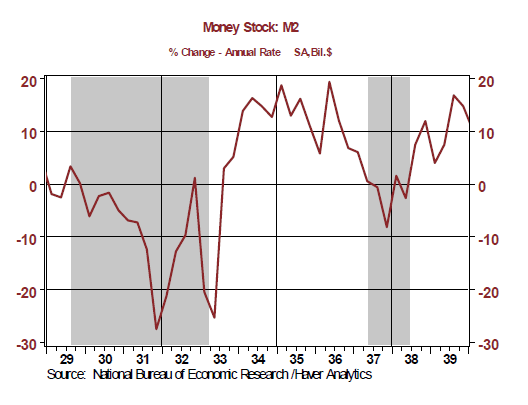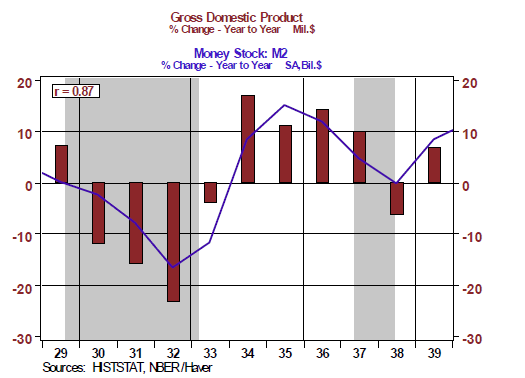Quantitative Easing During Mid 1930s Appears to Have Been Successful
Economics / Quantitative Easing Nov 10, 2010 - 03:44 AM GMTBy: Paul_L_Kasriel
 There is much skepticism as to whether the Fed's second round of quantitative easing, QE2, will be effective in stimulating the nominal demand for goods and services in the U.S. economy. It was explained in our November 4, 2010 US Economic and Interest Rate Outlook why the Fed's first round of quantitative easing, which ran from the end of November 2008 through the end of March 2010, was rather unsuccessful in stimulating nominal aggregate demand and why we believe that the Fed's just-announced second round will be more successful. Keying off Mark Twain's aphorism that although history may not repeat, it often rhymes, perhaps we can get some guidance as to whether QE2 will be successful from the results of the quantitative easing that was initiated in the second half of 1933.
There is much skepticism as to whether the Fed's second round of quantitative easing, QE2, will be effective in stimulating the nominal demand for goods and services in the U.S. economy. It was explained in our November 4, 2010 US Economic and Interest Rate Outlook why the Fed's first round of quantitative easing, which ran from the end of November 2008 through the end of March 2010, was rather unsuccessful in stimulating nominal aggregate demand and why we believe that the Fed's just-announced second round will be more successful. Keying off Mark Twain's aphorism that although history may not repeat, it often rhymes, perhaps we can get some guidance as to whether QE2 will be successful from the results of the quantitative easing that was initiated in the second half of 1933.
It was not the Federal Reserve that initiated quantitative easing in the second half of 1933, but the U.S. Treasury. In May 1933, Congress granted permission to the President of the United States to increase the U.S. dollar price of gold, which at that time was $20.67 per ounce. By January 1934, President Roosevelt had raised the dollar price of gold to $35.00 an ounce. By the stroke of a pen, the Treasury's hoard of gold increased in value by 69%. This, in effect, increased the Treasury's spendable funds by the increase in the value of its gold holdings.
The Treasury could use these funds created figuratively "out of thin air" to pay some of its bills without having to raise taxes or issue new securities. Thus, the Treasury could increase its spending without any other entity in the economy having to cut back on its current spending. The upward revaluation of the Treasury's gold holdings starting in the second half of 1933 was similar to today's Federal Reserve purchases of securities. The upward revaluation of the Treasury's gold holdings starting in the second half of 1933 increased the supply of money in the economy just as would have occurred if the Fed and the commercial banking system had increased their credit creation.
Chart 1 shows the behavior of the money supply -- currency held by the nonbank public, commercial bank demand deposits and commercial bank time deposits -- from 1929 through 1939. In the second quarter of 1933, the money supply contracted at an annualized rate of 25.3%. In the third quarter, after the dollar price of gold began rising, the money supply grew at an annualized rate of 3.0%. In each of the eight quarters ended 1935, the money supply grew at double-digit annualized rates.
Chart 1

Chart 2 shows the year-over-year percent changes in the annual averages of nominal GDP and the money supply. As money supply growth took off, so did nominal GDP growth (and real GDP growth, too.)
Chart 2

Different times and different magnitudes. But if the quantitative easing of the mid 1930s worked to stimulate nominal GDP, why wouldn't the recently-announced quantitative easing by the Fed work similarly, assuming the Fed puts enough zeroes into the program?
Paul Kasriel is the recipient of the 2006 Lawrence R. Klein Award for Blue Chip Forecasting Accuracy
by Paul Kasriel
The Northern Trust Company
Economic Research Department - Daily Global Commentary
Copyright © 2010 Paul Kasriel
Paul joined the economic research unit of The Northern Trust Company in 1986 as Vice President and Economist, being named Senior Vice President and Director of Economic Research in 2000. His economic and interest rate forecasts are used both internally and by clients. The accuracy of the Economic Research Department's forecasts has consistently been highly-ranked in the Blue Chip survey of about 50 forecasters over the years. To that point, Paul received the prestigious 2006 Lawrence R. Klein Award for having the most accurate economic forecast among the Blue Chip survey participants for the years 2002 through 2005.
The opinions expressed herein are those of the author and do not necessarily represent the views of The Northern Trust Company. The Northern Trust Company does not warrant the accuracy or completeness of information contained herein, such information is subject to change and is not intended to influence your investment decisions.
Paul L. Kasriel Archive |
© 2005-2022 http://www.MarketOracle.co.uk - The Market Oracle is a FREE Daily Financial Markets Analysis & Forecasting online publication.



